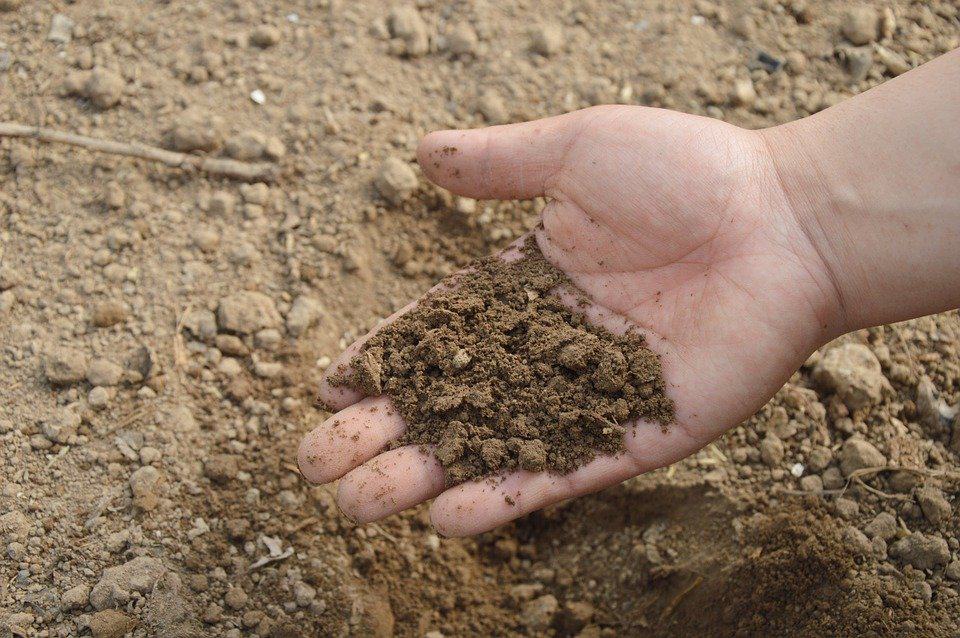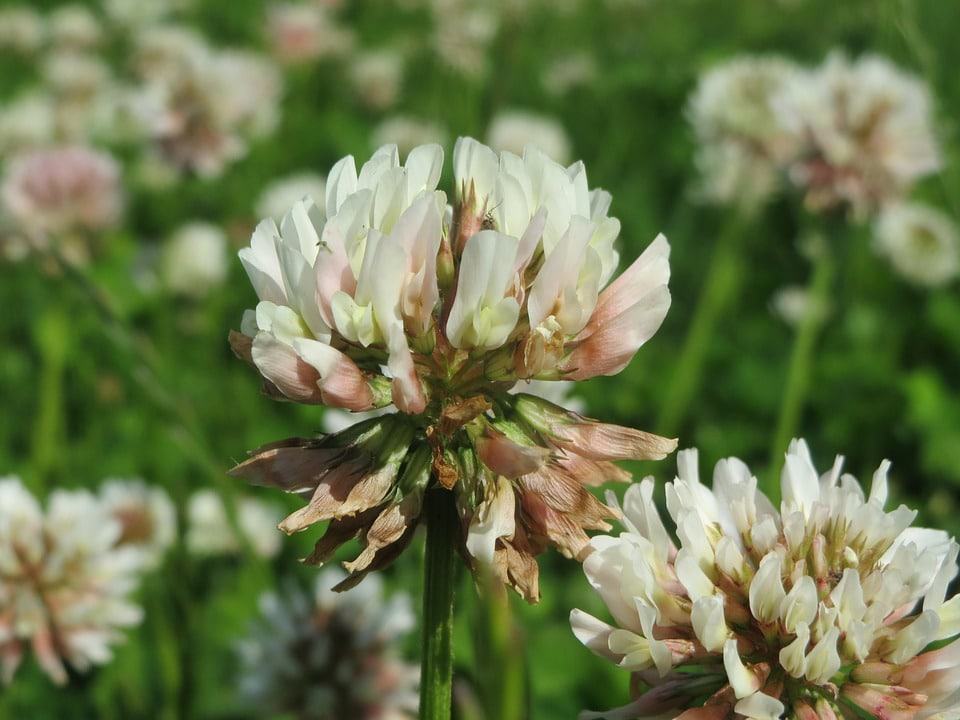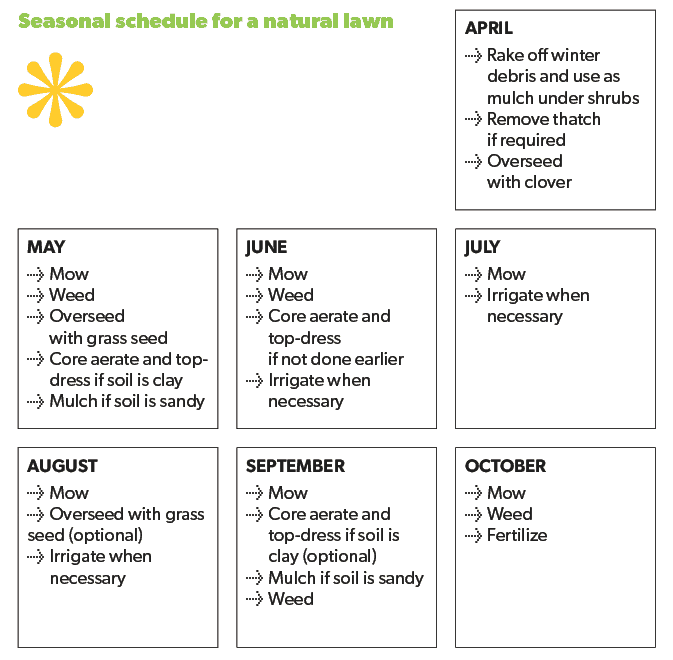
How to grow a healthy, natural lawn
It’s possible to have a healthy, green lawn without frequent applications of water, fertilizer and herbicides. It won’t be golf-green perfect, but that’s not necessarily a realistic — or environmentally sound — goal for a home garden.
Natural lawn care
A natural lawn is made up of many different types of plants that can withstand foot traffic and weekly mowing, and effectively cover the soil to prevent erosion. The difference between a natural mixed lawn and a uniform greensward at a golf course is sustainability.
With a modest amount of seasonal care, the natural lawn is able to thrive and grow thick, with only minimal help from you. It will seldom, if ever, have noticeable problems with insect invasion (such as chinch bugs), or turf diseases (like moulds), and so won’t require remedial treatment with chemicals.

If you have clay: aerate
The soil quality under a lawn is the most important influence on its diet and performance. If the soil is compacted clay and drains poorly, and the lawn is thin, use a core aeration machine (rented from an equipment-supply company) to cut out soil plugs, creating holes down into the compacted layer. With a soft leaf rake, brush a mixture of equal parts coarse sand and peat moss into the holes, batting the soil plugs around at the same time to break them up. This increases oxygen and fertility in the root zone, and can be done annually, in mid-spring or autumn. The lawn will grow stronger each year as drainage and fertility improve underneath. After aerating your lawn, wait two weeks and then top-dress the lawn by spreading one inch (2.5 cm) of peat moss or compost to add more organic content to the soil.

If you have sand: mulch
Sandy soils drain too quickly, causing lawns to starve as moisture and nutrients rapidly desert the root zone. Core aeration is not needed here, as sandy soil is already full of air and is too free-draining. Solve the resulting problems of excessive sand by boosting the organic content of the soil under the lawn. To do this, mulch with moisture-retentive materials. A one-inch (2.5-cm) layer of organic material — such as peat moss, garden compost, shredded leaves or well-rotted manure (individually or in any combination) — can be spread over the lawn twice annually in early spring and early autumn. Use a soft leaf rake to spread the organic mulch; it will make its way down to soil level and begin to enrich the root zone, retaining moisture and providing nutrients for the lawn’s growth.
Overseed and add clover
Thicken your lawn by overseeding annually in mid-spring or late summer with perennial rye grass seed, a resilient, drought-hardy grass that germinates in seven days. For shaded areas, use chewing fescue grass, which germinates in 14 days. Scatter the seed generously and cover it with ¾ inch (2 cm) of peat moss or soil; grass seed left exposed to air won’t sprout. Irrigate seeded areas using a fine-spray nozzle setting every day until the grass seedlings are well established.
Adding Dutch white clover (Trifolium repens) seed ensures the lawn will stay green during summer droughts because clover resists going dormant in heat. Clover is also a good companion to grass, and is able to convert gaseous nitrogen into a solid, making it available to neighbouring plants in the root zone, and adding a portion of the nitrogen requirement for the lawn. Purchase clover seed from a garden centre in early spring or directly from a turfgrass seed company, and distribute it over the lawn when the soil is cold and damp (no covering required).

Cut back on nitrogen
Lawns are damaged more by forced feeding than by a starvation diet, on the presumption that grass must make enormous leaps in blade growth as early as possible in spring. However, the reality is that each grass plant loses much of its root system over winter and must first grow new roots to reach groundwater to sustain itself; blade growth follows shortly after roots are actively growing. Applying commercial synthetic nitrogen fertilizer in early spring forces blade growth before roots are long enough to reach sustaining moisture. As summer arrives, lawns are still catching up on root growth just as heat and droughts begin, and the lawn may start to thin, as grass plants can’t keep up and die.
Fertilizers with an analysis like 28-3-4 (28% nitrogen, 3% phosphorus, 4% potassium) are dangerously high in sodium, which is bonded to the nitrogen molecules. When used repeatedly, the sodium will accumulate in garden soil, killing worms and important micro-organisms, eventually stunting the growth of grass — quite the reverse of what was intended by delivering such huge doses of nitrogen.
High-nitrogen applications also cause the buildup of thatch, a layer of dead stems and debris from excessive blade growth that can become sufficiently thick to keep air and water out of the soil. Energetic work in spring with a thatch rake will remove moderate thatch, but a thick layer requires a verti-cut machine to slice through the turf. This is certainly a problem no one wants, and can be avoided by staying away from high nitrogen numbers. It’s far better to look for an organic-based fertilizer with nutrient ratios close to 12-3-18, often sold at the end of summer as an autumn grass fertilizer. This level of nutrients in an organic base can be applied when day temperatures are around 5° to 10°C, too cool for grass to grow, but the fertilizer will be absorbed and stored in plant crowns for use in early spring.
Tip
If you want to fertilize the lawn only once annually, autumn is the optimal time. There is certainly no harm in fertilizing in mid-spring, about three weeks after the soil has thawed and drained, and grass plants have a few weeks to make new root growth. If you purchase autumn fertilizer, perhaps buy enough to also use for spring application, or check the garden centre for a similar strength organic-based fertilizer.
Water wisely
A natural lawn containing drought-hardy grasses and clover can withstand dry weather for quite a while before requiring irrigation. If two hot, dry weeks pass without a rain shower lasting two to three hours, it’s smart to get out the sprinkler and let it run for that amount of time, delivering at least one inch (2.5 cm) of water. Put a small bowl on the lawn, and with a measuring stick, check for when the collected water reaches one inch. Water delivered for shorter periods won’t be sufficient to penetrate to the root zone.
Watering at midday in direct sunlight or in windy conditions can cause as much as 50 per cent of the water to evaporate before it can be absorbed into the soil. The best time to provide water is in the early morning or early evening, when it can slowly percolate through the turf and into the soil. Try digging a small, discreet hole (at the edge of your lawn, for example) to check the soil moisture. At a depth of six inches (15 cm), soil should feel sponge-damp.
Even natural lawns need mowing
Mowing is made easy if the mower’s blades are sharpened each spring, a service your hardware store may offer. Sharp blades move swiftly through a lawn and ensure clean cuts, not ragged and torn tissues that pathogens can enter. Keep the lawn at a height of two to three inches (5 to 8 cm), and leave the short clippings where they fall. Grass clippings add organic mulch to the soil, and return their nitrogen content to the growing plants. Longer blade height also prompts roots to grow deeper underground, where they have access to more minerals and water. Mowing lawns to less than two inches (5 cm) allows sunlight to reach the soil, where it helps germinate weed seeds and heats up the root zone — not something you want to encourage.
Develop a weed strategy
Many of the plants in a natural lawn are desirable, but there might be one or two you want to remove. Your province or municipality may have prohibited the use of herbicides to protect your health and the environment.
Frequent mowing keeps even the wildest weeds looking presentable, but if you want to remove the most troublesome perennial weeds by hand, here’s how:
Plan weeding sessions for cool spring and autumn months. Decide which area to work in, and what size of weeds to dig out. It’s acceptable to remove only the largest weeds; smaller ones can grow until they’re bigger and you’re again in the mood to tackle them.
Weed when the soil is wet, after rain or irrigation; plant roots are slippery and won’t grip the soil. Use a tool that fits your hand comfortably. It may not be designed for weeding — it could be an old dinner knife — what matters is that it works well for you. Slide the tool down the side of tap-rooted dandelions or under fibrous-rooted plantains, and loosen them. Grasp the crown at the base of the plant, not the leaves, and gently pull until the root slips out. Removing at least two-thirds the length of taproots ensures they won’t regenerate. If you remove a large patch of weeds, reseed with a combination of grass and clover.
Seasonal schedule for a natural lawn


Looking for help with goutweed…invading my lawn…. very large area
My lawn is being invaded by goutweed….an area 30 feet square has grown on the edge of my lawn. Any good ideas on how to eliminate it safely?